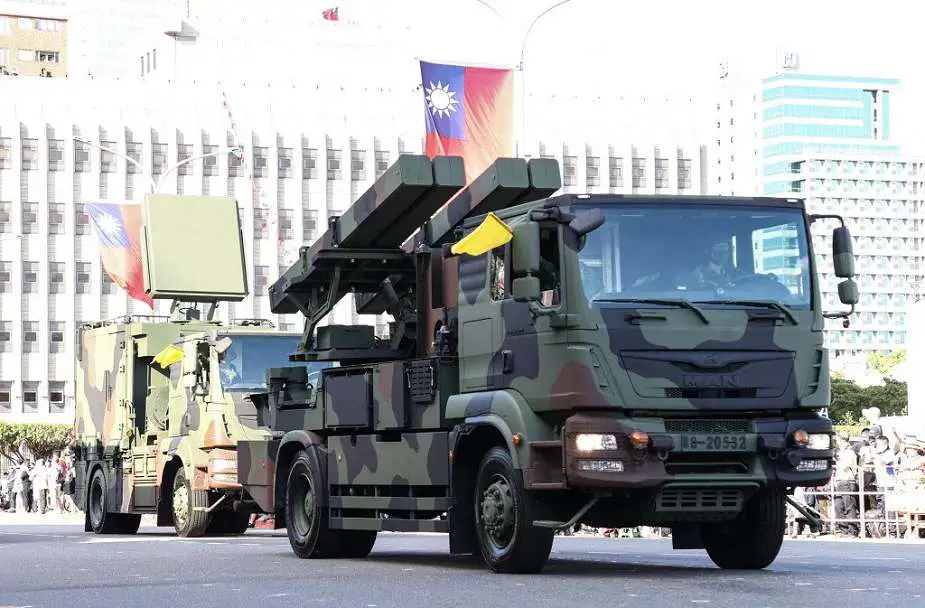Breaking news
Taiwan Acquires TC-2 Air Defense Missile Systems to Counter China's Military Threats.
In a strategic move to counter the increasing military threats from China, Taiwan has invested US$278 million to bolster its air defense capabilities. This investment, as reported by "Taiwan News", an English-language online newspaper, focuses on the acquisition of advanced air defense missile systems, including 30 TC-2 mobile missile launchers, six combat control centers, six phased-array radar systems, and 246 Sky Sword II air defense missiles.
Follow Army Recognition on Google News at this link

The TC-2 is a Taiwanese-developed air defense missile system. (Image sourced from Reddit)
One of the most visible forms of Chinese pressure has been the significant increase in military activity around Taiwan. This includes frequent incursions by Chinese military aircraft into Taiwan's Air Defense Identification Zone (ADIZ) and naval exercises in the Taiwan Strait. These actions are not just demonstrations of military might; they also serve as a test of Taiwan's defense capabilities and resolve. Such military maneuvers are often interpreted as a means of intimidation and a signal of Beijing's readiness to assert its claims over Taiwan. (Picture Source Reddit)
In addition to military posturing, China has been actively working to diplomatically isolate Taiwan on the international stage. This effort involves persuading countries that formally recognize Taiwan to switch their recognition to the People's Republic of China (PRC). Furthermore, Beijing has been blocking Taiwan's participation in international organizations, effectively limiting its global diplomatic presence and influence. This strategy aims to undermine Taiwan's international standing and legitimacy as a separate entity from the PRC.
These actions are part of a broader strategy by China to assert its claims over Taiwan, reflecting the longstanding and deep-rooted tensions between the two. The increasing military and diplomatic pressure highlights the complex and often strained relationship, underscoring the challenges Taiwan faces in maintaining its de facto independence while navigating the delicate balance of cross-strait relations.
Central to this air defense system acquisition is the TC-2 air defense system, which has been rigorously tested and refined. Initially facing challenges in meeting the Taiwanese Army’s requirements, the system was eventually approved for large-scale production after successful evaluations in July.
The TC-2 system's land-based version, the TC-2N, features the missile in a sealed container-launcher. The system's canister is 4 meters (13 feet) long, and the combined weight of the canister and missile is about 350 kg (770 lb). The missile is equipped with midcourse inertial guidance, a data link, terminal active radar guidance, and an electronic counter-countermeasure (ECCM) capability. However, without the booster found in its naval counterpart, the TC-2N's effective range is limited to 15 km (9.3 mi).
Complementing the TC-2 system is the Sky Sword II missile, developed by Taiwan's National Chung-Shan Institute of Science and Technology. This missile can reach up to 15 kilometers in range and is a key component of Taiwan's layered air defense strategy. The TC-2 air-defense system, when deployed, will work in conjunction with the U.S.-made Avenger missile system. This combination is intended to fill gaps in Taiwan's air defense, achieving a "layered interception" effect. Each TC-2 system is capable of firing between 16 and 20 Sky Sword II missiles, providing a robust defense against various aerial threats.
This significant investment in advanced military technology is a clear indication of Taiwan's commitment to defending its sovereignty and maintaining a credible defense posture amidst the growing regional tensions. The deployment of these systems is expected to significantly enhance Taiwan's air defensive capabilities, contributing to the stability and balance of power in East Asia.
Defense News November 2023




























